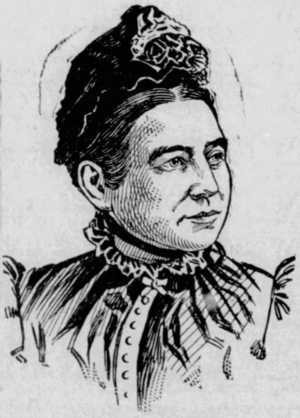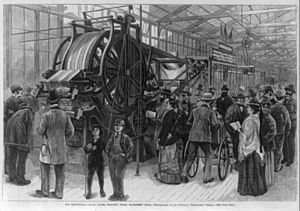Maria E. Beasley facts for kids
Quick facts for kids
Maria E. Beasley
|
|
|---|---|

Maria E. Beasley (1897)
|
|
| Born |
Maria Hauser
c. 1836 North Carolina, United States
|
| Died | 1913 (aged 76–77) |
| Nationality | American |
| Occupation | Entrepreneur, inventor |
| Years active | c. 1878–1898 |
| Known for | Barrel-making machines and improvements to the life raft |
| Spouse(s) | John Q. Beasley |
| Children | 2 |
Maria E. Beasley (born Maria Hauser; around 1836–1913) was an American businesswoman and inventor. She is best known for creating machines that made barrels and for improving the life raft.
Contents
Maria Beasley's Early Life
Maria Hauser was born in North Carolina around 1836. She came from a wealthy family. Even as a child, Maria loved mechanics and building things. She even built several working watermills by herself!
When Maria visited her grandfather, Jacob Hauser, she learned about making barrels. He owned a distillery in Kentucky. This early experience sparked her interest in how things were made.
Maria Beasley's Career as an Inventor

Between 1878 and 1898, Maria Beasley received fifteen patents in the United States. A patent is like a special license that protects an inventor's idea. Her inventions included a footwarmer, a better life raft, and a device to stop trains from derailing.
Her biggest success came from her machines that made barrels. She even licensed one of her patents to the Standard Oil Company. Maria also showed her inventions at big events like the World's Industrial and Cotton Centennial Exposition. She started two companies that designed and made barrels. One of her companies later sold for $1.4 million!
Maria Beasley's Amazing Inventions
The Footwarmer
In 1878, Maria Beasley got her first patent for a footwarmer. This invention used a chamber of water heated by a lamp or direct flame. Smoke and steam went out through two pipes.
The user could rest their feet on a soft surface above the heated water. To prevent fires, Maria designed the lamps to be mounted on supports. These supports could slide in and out. The lamps would also stand upright if the footwarmer tipped over, making it safer.
Barrel-Making Machines
Before Maria's inventions, people made all barrels by hand. This was a slow and difficult process. Maria wanted to create a machine that could put hoops on barrels quickly and easily.
In 1881, she received her first patent for a barrel-hooping machine. She got a second patent for an improved version in 1882, which was also patented in the United Kingdom. Her machine could fit hoops tightly onto both sides of a barrel at the same time.
The improved design could handle different shapes of barrel parts. It used special arms and jaws to hold the wood firmly. Her final machine could hoop 1,600 to 1,700 barrels every day! This was much more than a person could do by hand.
By 1912, Maria's barrel-hooping patent was earning her $20,000 each year. This money came from royalties, which are payments for using her invention.
Besides her hooping machines, Maria also patented five other inventions related to barrels. These included a process for making barrels (1886), two other barrel-making machines (1884 and 1888), a machine for setting up barrels (1888), and a process for cutting and notching hoops (1891).
Improved Life Raft Design
Maria Beasley also received two patents for an improved life raft, in 1880 and 1882. Her raft had a base of metal floats that could collapse. This made it more flexible and easier to store on a ship. It also included airtight containers to protect food and supplies.
In her updated design, Maria made the raft easier to use even if it flipped over. She changed the surface of the metal floats and added an adjustable guardrail.
Anti-Derailment Device for Trains
In 1898, Maria Beasley received a patent for a device to stop trains from derailing. Derailing means when a train leaves its tracks. Her invention combined a guardrail and a locking device.
The guardrail had a strong top edge called a flange. This flange was on the inner side of the train track. It connected with a special mechanical catch, called a detent, on the train. If a train car started to derail, the detent and flange would prevent it from leaving the track. This would help the train get back to moving normally.
Maria Beasley's Personal Life
Maria married a doctor from North Carolina named John Q. Beasley. She took his last name. They had two sons, C. Oscar and Walter.
Maria Beasley's Death
Maria Beasley passed away in 1913.
Interesting Facts About Maria E. Beasley
- When she was just thirteen years old, Maria built a small sailboat. It was strong enough to carry both her and her dog safely!
- Maria patented a total of fifteen inventions in the United States. She also got extra patents in Britain for two of her inventions.
- Besides her barrel inventions, she also created a machine for pasting the upper parts of shoes (1882), a steam generator (1886), and a bread-making machine.
See also
 In Spanish: Maria Beasley para niños
In Spanish: Maria Beasley para niños


